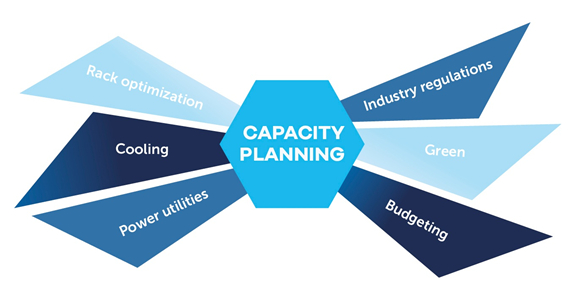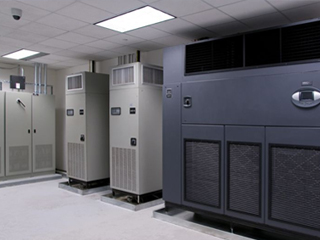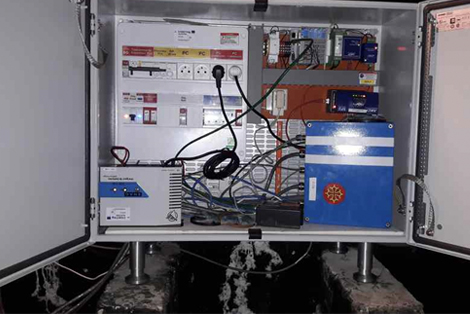Data centers are huge investments, therefore maximizing its capacity is essential. Planning of the layout, cooling and airflow plays an important role in making sure that every space and component is utilized to its full potential. Therefore power and cooling management strategies are vital to ensure there is no stranded capacity. But what do we mean by this? In this article we will be understanding stranded capacity.
Monitoring power and cooling capacity are the operational norm in a data center. Capacity refers to measuring power, cooling, and spaces present in the facility. A significant consideration is given to these because they primarily affect a data centers output. If components or data center infrastructure don’t provide the necessary support for critical IT load, it becomes stranded capacity. Stranded capacity specifically pertains to installed capacity, which refers to cooling, power, and space components.
What is Stranded Capacity?
Power, cooling, and space are interlinked components in the data center. They may be evaluated individually, but that doesn’t give a comprehensive assessment. Because of their interrelation, they should be gauged together. Stranded capacity happens when there is an imbalance in any of the three components. For example, servers that can not achieve full use because they are under cooled, or cooling capacity that is not being used to cool IT equipment.
Specifically, power capacity is stranded when IT or cooling equipment is not being used to its full potential. This results in consumption of non-useful power. Suppose sites are designed to operate in 500 W/sq. Ft. and the data center only utilizes half of it during operation; there is stranded power as 50% of the power is not in use.
Why Stranded Cooling Capacity Should Be Addressed?

Photo Credit: media.istockphoto.com
Despite their interconnected nature, stranded cooling capacity is the costliest. It is easy to overlook because cooling is more complex to monitor and gauge. Stranded cooling capacity depicts that a particular part of the mechanical system is working but does not accord cooling outputs for IT units. This is considered a waste of cooling energy.
The reality in data center operations provides a straightforward narrative that stranded cooling capacity happens. More often than not, we fail to notice it.
-
Overrunning Cooling Capacity
Stranded capacity comes from overloading cooling units to maintain a data center’s environmental condition comprehensively. While this counts as positive reinforcement, too much can be a detriment. Research conducted by Upsite uncovers there is an overload of 3.9 times in cooling capacities from 45 sites. The cooling capacity is more than three times the IT load. A glaring testament that running extensive fan horsepower is not always the solution. The fans are running unnecessarily, for that matter. Energy is wasted, and more, capital equipment is under used.
- Operating At Lower Temperature Set Points
There are standard temperature conditions to which cooling units can run. Manufacturers prescribe a standard 75°F. It also suggests a 45% relative humidity condition. Again, to curb any chance of overheating, most data centers run cooling units at lower set points. Hence, rate capacity is not achieved. In order to run at lower standard conditions, additional cooling units are necessary. This is impractical if the budget allocation is not as flexible. It also degrades the capacity of the unit to maintain standard return-air temperature.
-
Relative Humidity Has Effects On Cooling Capacity
Relative humidity affects moisture and the process of condensation inside the data center. With higher relative humidity, condensation occurs on cooling unit coils. This is referred to as latent cooling. When liquid condenses, it gives off more heat.
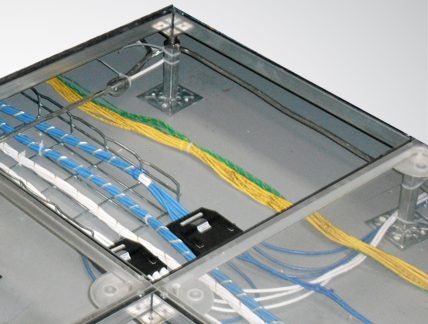
Photo Credit: datacenterstore.com
As more heat is present in the air, it also consumes cooling capacity. This is a direct dissipation of cooling capacity, as allocation should lower the air temperature. With lower temperatures, supply air conditions will be perfect to cool IT equipment.
-
Wrong Perforated Tile Application
Constant planning review is necessary for data center design. One part of it is to ensure that the ground arrangement is feasible to the IT load. Any wrong placement of perforated tile, for that matter, will result in stranded cooling capacity. This may sound basic, but many data centers are still misplacing perforated tiles in open areas or hot aisles. What it does is hastens the passing of cooled air away from the raised floor. With an increased volume of air leaving, cooling the IT equipment is put off. Considering the volume of air unused because of the wrong placement of tiles is a foolproof example of stranded capacity.
-
Cable Openings Are Deal Breakers
Cable openings are of the exact nature with perforated tiles. When placed wrongly or unsealed, it is a passageway for bypass conditioned air. Any air escape strands any cooling capacity would have been valuable for IT infrastructure.
Traditional Data Center Capacity Planning Flaw
Capacity planning is an extensive endeavor. Datacenter capacities need to balance power, space, and cooling capacities. Any disproportion from these parameters will restrict data center capacity planning.
The same restriction is observed in planning traditional data centers. In the past, data center capacity planning used this formula as a reference:
Future Resource = Current Usage x (1 + Normal Growth + Planned Growth) + Headroom
While this formula aims to simplify the quantification of data center capacities, it overlooks some significant components. One of which is the non-accounting of load variability on servers. Granted that this formula provides a standard inference point, it doesn’t comprehensively cover capacity planning as a whole.
Advanced planning methodology is essential because of the continuous evolution of data center operations. As changes happen, critical load requirements keep pace. These are unpredictable without comprehensive capacity planning. As such, constant accounting of load variables will ensure improved capacities and requirements. This is why despite a standard formula, mismatch stems from the ongoing evolution of requirements that elicits proper balancing.
Investing In An Effective Capacity Management System

AKCPro Server for Data Center Capacity Planning
As change is constant in a data center, identifying and highlighting stranded capacity is vital. But prevention is better than cure; hence, finding ways to avoid encountering the problem is ideal.
However, this is easier said than done. Creating a capacity management system requires a defined measurement standard and constant data analysis. Doing it manually may not be the most logical step. Also, data centers are now digitizing every component there is. This assumes that even capacity management activities should follow the same dynamics.
The widely-sought solution for an effective capacity management system is integrating a data center infrastructure management (DCIM) software. The DCIM software is handy in defining data points. With granular visibility, problems like stranded cooling capacity are negated. DCIM software is also critical incapacity planning. They can be programmed to provide thresholds to initiate alerts if plans supersede any data point.
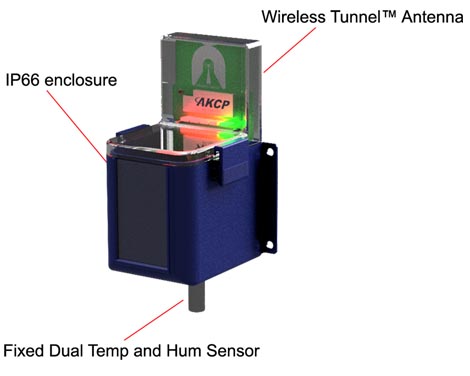
Wireless Temperature and Humidity
AKCP DCIM Solution has a wide array of utilization coverage. Most notably, AKCP solutions have a comprehensive technology to optimize power, cooling, and space capacities. As the world leader in SNMP-based data center monitoring solutions, AKCP can provide specific and general monitoring capacities. True to form, AKCPro Server sensors provide environmental monitoring visibility. It can roll out multi-cabinet monitoring solutions.
Moreover, the Rack+ solution is an integrated intelligent rack or aisle containment system suitable for any data center layout and design. AKCP boasts robust DCIM AKCPro Server software. When installed, dedicated rack maps can display cabinet analysis sensor data that are a valuable visual representation of server racks. It is also a viable option for hot and cold aisle containment monitoring. Granular visibility on sectional vies on aisles is one critical feature that facility managers can benefit from.
One benefit of investing in DCIM as a capacity management system tool is modeling component changes. It provides a prototype sequence to check modeling plans. This way, problems are quickly identified and solved instantaneously.
The Essence Of Understanding Stranded Capacity
In line with the issue of stranded cooling capacity, it is easier to avoid the problem than to correct it afterward. But even so, many data centers fall trap to efficiency measures that don’t have concrete returns. It is a consistent application and reapplication of primary data center practical cues that addresses the problem. However, this is taxing and requires repetitive effort. It also undermines the streamlining action steps as part of operational management.
Tackling stranded cooling capacity is straightforward. Ensure a balanced ratio of cooling inputs to the IT cooling requirement. A key ingredient for a precise data analysis lies in a sound DCIM capacity management system. Aside from its intrinsic monitoring value, DCIM software does not need constant groundwork. The promise of calibrated and precise data collection for better analysis optimizes the identification of cooling capacity strands. With evidence-based notification, preventing capacity strands from happening is easier. But more than anything, it assures a sustained and efficient way of maintaining good data center performance.
Reference Links:
https://www.upsite.com/blog/5-ways-stranded-cooling-capacity-impacts-your-data-center/
http://blog.e-i-eng.com/data-center-capacity-planning-what-is-stranded-capacity-and-how-to-avoid-it
https://blog.se.com/datacenter/2012/12/19/dont-leave-your-data-center-stranded-out-in-the-cold/

